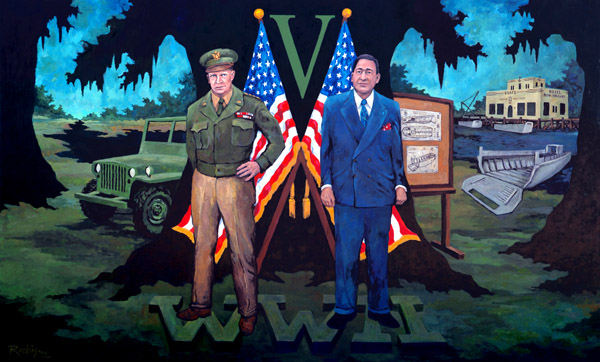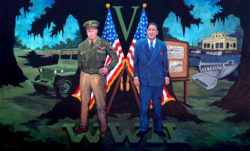World War II
Like the rest of the nation, Louisiana experienced many changes during World War II. Federal spending helped boost the state’s economy and new employment opportunities proliferated.

Courtesy of George Rodrigue.
A painting depicting Andrew Higgins and Dwight Eisenhower, 2009. George Rodrigue, artist.
Like the rest of the nation, Louisiana experienced many changes during World War II. Federal spending during the war helped boost the state’s economy from its agricultural collapse following World War I, and new employment opportunities proliferated. This, in turn, led to population shifts, since many of these new jobs were in cities, especially in the southern part of the state. By 1950, Louisiana had been transformed from a mostly rural to a mostly urban state. The urban population increased by 39.1 percent from 1940 to 1950, while the rural population declined by 4.6 percent. The 1950 US Census was the first to report that Louisiana’s population was now more urban (50.8 percent) than rural (49.2 percent). In addition to this vital growth in agriculture and industry, World War II brought about more subtle shifts on the home front, reshaping the state’s social institutions, educational facilities, gender roles, and race relations.
Military Facilities and Training
Among the most obvious changes World War II brought to Louisiana were the construction of new military facilities and the expansion of existing ones. Camp Beauregard in Rapides Parish, the site of large-scale training during World War I, was converted to a training camp for the Louisiana National Guard during the interwar years and then reactivated as an Army training camp in 1940. Construction of Camps Livingston and Claiborne in Rapides and Camp Polk in Vernon Parish rapidly followed. These camps and others throughout the state trained soldiers, brought construction jobs to Louisiana, and provided markets for area farmers.
Beginning in 1940, the state hosted a series of Army training drills, collectively known as the Louisiana Maneuvers. These exercises brought numerous soldiers into the state, along with their attendant paychecks. The 1941 maneuvers, the most massive of the entire series, were the largest peacetime training maneuvers ever conducted by the US Army. Top military commanders, including George Marshall, Dwight Eisenhower, George Patton, Joseph Stilwell, and Omar Bradley, among many others, came to central Louisiana to either command troops or observe the exercises. These maneuvers are remembered not only as important training sessions, but also as economic opportunities for local merchants who saw the soldiers as potential customers. They were seldom disappointed. The drills came to an end in 1944, when the troops were dispatched to the D-Day invasion of France.
Agriculture, Labor, and Industry
More generally, the war effort resulted in economic growth in the state’s agriculture and industry. The increased demand for the traditional Louisiana agricultural trinity—sugarcane, cotton, and rice—helped the state’s farmers recover from the economic devastation of the Great Depression. World War II also accelerated the industrialization of Louisiana’s economy, as major establishments provided vital material and petrochemicals to the war effort. While New Orleans remained the state’s major industrial area, Baton Rouge, Shreveport, Monroe, Alexandria, Lafayette, and Lake Charles also served as important industrial centers. In Shreveport, for example, the J. B. Beaird Company employed approximately eight hundred people to make shell casings, tanks for the production of synthetic rubber and storage of high-octane gasoline, landing barge anchors, and armored tank parts. Though other towns lagged behind, even they slightly increased their industrial production. In 1941, the War Department announced its decision to build an ordnance plant, consisting of 430 buildings, in Minden, a small town near Shreveport in northwestern Louisiana.
Andrew Higgins created the state’s largest wartime industry in New Orleans. His company’s most famous product, the Higgins Boat, was a landing craft manufactured in several specialized models and used in amphibious landings in both the European and Pacific theaters. Higgins Industries also built Liberty Ships in New Orleans, while Consolidated Vultee, a California business, built airplanes in the city. Smaller businesses throughout the state were either created or expanded as a result of wartime needs.
The increased demand for war materials and industrial production resulted in a relative shortage of labor. In other sectors, such as agriculture, many farmers employed Axis prisoners of war incarcerated in the state. By 1945, about fifteen thousand prisoners of war toiled in the state’s fields. Their efforts met with varying degrees of success, depending on the crop and the prisoners’ abilities. The labor shortages also led to an acceleration of mechanization, with the sugar industry leading the way. Cotton and rice production lagged behind, however, because of characteristics unique to each crop. Engineering technology simply did not advance sufficiently to build a successful mechanical cotton picker until the 1945 harvest season, when the first one in Louisiana was used in southern Rapides Parish. Mechanization of rice harvesting did not occur until after the war, when researchers solved problems related to the fact that successful mechanical rice harvest required a moisture content in the grain far above that required for successful storage. The increased use of tractors affected production of all three crops.
African Americans and women, two groups historically denied full access to many social and economic opportunities, also added to the wartime labor pool. Ironically, many found it easier to enjoy the rights of equality during the war than before or after. Many African Americans moved out of low-paying jobs and into more lucrative employment opportunities formerly dominated by white males. Louisiana’s system of segregation, often referred to as Jim Crow, persisted and many Black workers encountered racism, but inroads were made. Women, customarily relegated to civic pursuits, housework, or “women’s jobs” such as teaching or nursing, became stock board markers, parking lot attendants, taxicab drivers, welders, aircraft mechanics, newspaper deliverers, machinists, and store managers, among other jobs.
Life on the Home Front
Despite the economic prosperity it engendered, World War II also curtailed and limited the lives of many Louisianans. Shortages and rationing removed some consumer goods from store shelves and made others difficult to obtain. Residents who wanted sugar, for example, had to sign up to receive sugar-rationing books. Finally having money to spend after years of doing without during the Depression, Louisianans with wartime jobs found the shortages galling. Rationing of gasoline and tire supplies, for example, severely hindered Americans’ traditional freedom of movement.
Even with these shortages and restrictions, Louisianans continued to socialize during this period, but their social festivities, like other aspects of their lives, reflected the war’s impact. In towns near military bases, young women were frequently recruited to attended military dances. In New Orleans, the Young Men’s Business Club scheduled picnics, athletic contests, and seafood dinners for visiting servicemen. Residents of Baton Rouge sometimes opened their homes to soldiers for a meal, while the Elks Club and YMCA provided showers for soldiers passing through the city. Similarly, a Masonic Service Center in Alexandria furnished stationery, stamps, magazines, books, newspapers, games, and puzzles to soldiers. In December 1941, the first United Service Organization (USO) center in the United States opened in DeRidder, serving soldiers at nearby Camp Polk.
On a more personal level, parties and family events throughout the state increasingly featured military themes. Even holiday celebrations sometimes assumed a military tinge. Traditional recreational activities were replaced by civilian defense, scrap collection drives, and war bond sales, providing Louisianans with a sense of participation in the struggle to rid the world of totalitarianism. Merchants set aside room in their stores for war stamp and bond sales; newspaper delivery boys sold war stamps; and air raid wardens and aircraft spotters scanned the skies. Louisianans rummaged through piles of refuse seeking material that could be recycled. They donated kitchen utensils—relics from the Civil War and World War I, as well as family heirlooms—to scrap metal collection drives. They bought war stamps and bonds with such enthusiasm that the state exceeded its sales quota in each war bond drive.
In addition to these social transformations, Louisiana’s educational system adapted in response to the nation’s military endeavors. Many primary and secondary schools provided the technical training, in both industry and agriculture, necessary to support the war effort. Schools offered courses such as welding, electricity, sheet metal working, automobile mechanics, radio repair, woodworking, lathe operation, drill press operation, and agriculture to nontraditional students. They also modified the high school curriculum by adding courses in military courtesy and customs of the armed forces, infantry drill regulations, military sanitation and first aid, military history and policy, military organization, rifle marksmanship, map reading, tactical training as scout, observer, sentinel, listener, sniper, or messenger, automatic rifle fire, combat training, recognition of propaganda, global geography, wartime economy, and for those students who would not be inducted into the military, courses in how to increase production of milk, poultry, eggs, pork, beef, mutton, lamb, wool, soybeans, peanuts, and vegetables. Schools also participated in wartime scrap collection and stamp sales drives, and became registration and distribution centers for the federal government’s rationing program.
Meanwhile, Louisiana educators rededicated themselves to inculcating patriotism among students. Patriotic themes dominated history and civics courses, but teachers also urged their students to read more and excel in math and science. These activities were not, however, universally popular. Jehovah’s Witnesses in Avoyelles Parish objected to their children reciting the pledge at school because it conflicted with their religious beliefs. The State Board of Education declined to issue a ruling on the question, leaving parish authorities to address the problem. State Board of Education records do not indicate that this problem surfaced in any other parish.
At the university level, Louisiana colleges typically suffered from declining enrollments as male students joined the military, though military training programs partially offset the resulting loss of income. Louisiana Polytechnic Institute (now Louisiana Technical University), Southwestern Louisiana Institute (now the University of Louisiana at Lafayette), and Louisiana State Normal College (now Northwestern State University) all launched Army or Navy training programs. Southeastern Louisiana College (now Southeastern Louisiana University) acquired a Civilian Aeronautics Authority training program, while Southwestern and Southern University offered agricultural refresher courses. Two private institutions, Centenary College and Louisiana College, acquired Army Air Force programs. Additional challenges in higher education included temporary curtailment of collegiate athletics because of the shortage of male students and fuel rationing, which made team transportation difficult.
Conclusion
The ultimate impact of World War II on Louisiana continues to be debated. In The Emergence of the New South (1977), George Brown Tindall maintains that the southern states emerged from World War II with social and economic conditions very different from those of 1939. The changes in Louisiana generally support this interpretation, even though life in the postwar period resumed many of its prewar aspects. After the thousands of troops left, Louisiana’s military training camps were either abandoned or their functions were reduced, but other wartime changes proved more difficult to reverse. Advances made by both African Americans and women, for example, proved to be only the beginning of battles for equality. Many women reverted to traditional roles after the war, and African Americans endured the trials of massive resistance, but their wartime experiences provided a foundation for future struggles to achieve equality.
